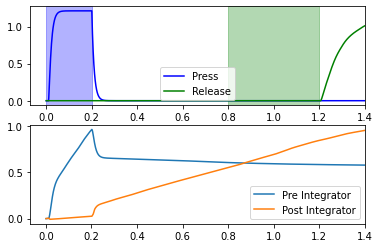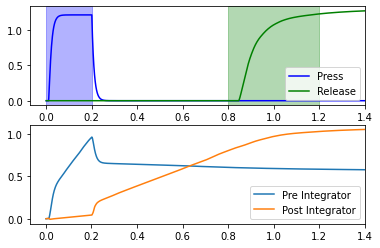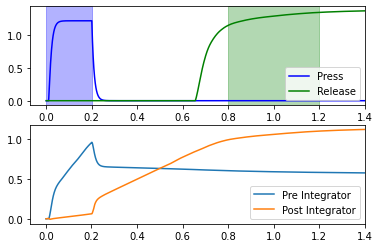Additional tips and tricks for designing networks¶
This tutorial assumes that you have read the network_design tutorial, and have designed a network or two. Here, we will give a few advanced tips and tricks for designing networks that can be reused flexibly. In particular, these tips will use the config system, so we will also assume that you have gone over the config tutorial.
Briefly, the general principles covered in this tutorial are
Accept
**kwargsto pass through network argumentsAccept a config argument for groups of parameters
We will demonstrate these principles using the two examples from the network_design tutorial.
[1]:
%matplotlib inline
import matplotlib.pyplot as plt
import nengo
from nengo.dists import Choice
from nengo.processes import Piecewise
from nengo.utils.ipython import hide_input
def test_integrators(net):
with net:
piecewise = Piecewise({
0: 0,
0.2: 0.5,
1: 0,
2: -1,
3: 0,
4: 1,
5: 0
})
piecewise_inp = nengo.Node(piecewise)
nengo.Connection(piecewise_inp, net.pre_integrator.input)
input_probe = nengo.Probe(piecewise_inp)
pre_probe = nengo.Probe(net.pre_integrator.ensemble, synapse=0.01)
post_probe = nengo.Probe(net.post_integrator.ensemble, synapse=0.01)
with nengo.Simulator(net) as sim:
sim.run(6)
plt.figure()
plt.plot(sim.trange(), sim.data[input_probe], color='k')
plt.plot(sim.trange(), sim.data[pre_probe], color='b')
plt.plot(sim.trange(), sim.data[post_probe], color='g')
hide_input()
[1]:
1. Accept a **kwargs argument¶
The standard nengo.Network accepts a number of arguments, including the widely used seed and label arguments. Sometimes it is helpful to be able to set these on your custom networks too. While there is nothing wrong with explicitly passing these arguments along, it is less typing to use the Python **kwargs construct. This special argument allows a function to accept any number of keyword arguments which we can then pass into the Network constructor.
[2]:
def Integrator(n_neurons, dimensions, tau=0.1, **kwargs):
with nengo.Network(**kwargs) as net:
net.input = nengo.Node(size_in=dimensions)
net.ensemble = nengo.Ensemble(n_neurons, dimensions=dimensions)
nengo.Connection(net.ensemble, net.ensemble, synapse=tau)
nengo.Connection(net.input, net.ensemble, synapse=None, transform=tau)
return net
net = nengo.Network(label="Two integrators")
with net:
# Make both integrators use LIFRate neurons
net.config[nengo.Ensemble].neuron_type = nengo.LIFRate()
net.pre_integrator = Integrator(50, 1, label='pre')
net.post_integrator = Integrator(50, 1, label='post')
nengo.Connection(net.pre_integrator.ensemble, net.post_integrator.input)
test_integrators(net)
/mnt/d/Documents/nengo-repos/nengo/nengo/builder/optimizer.py:639: UserWarning: Skipping some optimization steps because SciPy is not installed. Installing SciPy may result in faster simulations.
"Skipping some optimization steps because SciPy is "
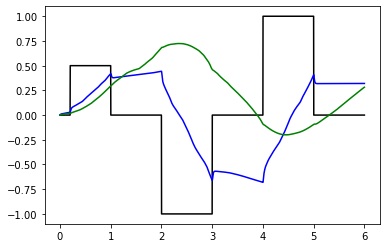
[3]:
print('pre integrator label:', net.pre_integrator.label)
print('post integrator label:', net.post_integrator.label)
pre integrator label: pre
post integrator label: post
2. Accept a config argument for groups of parameters¶
Often, you will not want to use the network-level defaults for all of your objects. Some objects need certain things overwritten, while others need other values overwritten. Again, it is possible to deal with this issue by adding more and more parameters, but this quickly gets out of hand. Instead, add a small number of arguments that optionally accept a config object, which allows for setting multiple parameters at once.
In the coupled integrator network example, we make two connections. We have to be careful changing the defaults for those connections, as they are wildly different; one is a recurrent connection from an ensemble to itself, while the other is a connection from a node to an ensemble. We will accept a config object for the recurrent connection to make this easier.
[4]:
def ConfigurableIntegrator(
n_neurons, dimensions, recurrent_config=None, **kwargs):
net = nengo.Network(**kwargs)
if recurrent_config is None:
recurrent_config = nengo.Config(nengo.Connection)
recurrent_config[nengo.Connection].synapse = nengo.Lowpass(0.1)
with net:
net.input = nengo.Node(size_in=dimensions)
net.ensemble = nengo.Ensemble(n_neurons, dimensions=dimensions)
with recurrent_config:
nengo.Connection(net.ensemble, net.ensemble)
tau = nengo.Config.default(nengo.Connection, 'synapse').tau
nengo.Connection(net.input, net.ensemble, synapse=None, transform=tau)
return net
net = nengo.Network(label="Two integrators")
with net:
# Make both integrators use LIFRate neurons
net.config[nengo.Ensemble].neuron_type = nengo.LIFRate()
net.pre_integrator = ConfigurableIntegrator(50, 1)
# Give the post_integrator a shorter tau (should make integration fail)
recurrent_config = nengo.Config(nengo.Connection)
recurrent_config[nengo.Connection].synapse = nengo.Lowpass(0.01)
net.post_integrator = ConfigurableIntegrator(
50, 1, recurrent_config=recurrent_config)
nengo.Connection(net.pre_integrator.ensemble, net.post_integrator.input)
test_integrators(net)
/mnt/d/Documents/nengo-repos/nengo/nengo/builder/optimizer.py:639: UserWarning: Skipping some optimization steps because SciPy is not installed. Installing SciPy may result in faster simulations.
"Skipping some optimization steps because SciPy is "
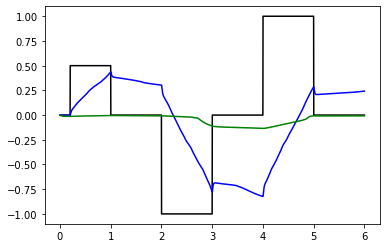
Longer example: double integrator network¶
Recall in the previous tutorial that we created a model that released a lever 0.6 to 1.0 seconds after pressing a lever. Let’s use the above principles, and the config system in general, to improve the code constructing this model.
[5]:
def controlled_integrator(n_neurons,
dimensions,
recurrent_config=None,
**kwargs):
net = nengo.Network(**kwargs)
if recurrent_config is None:
recurrent_config = nengo.Config(nengo.Connection)
recurrent_config[nengo.Connection].synapse = nengo.Lowpass(0.1)
with net:
net.ensemble = nengo.Ensemble(n_neurons, dimensions=dimensions + 1)
with recurrent_config:
nengo.Connection(
net.ensemble,
net.ensemble[:dimensions],
function=lambda x: x[:-1] * (1.0 - x[-1]))
return net
def medial_pfc(coupling_strength,
n_neurons_per_integrator=200,
recurrent_config=None,
tau=0.1,
**kwargs):
net = nengo.Network(**kwargs)
with net:
recurrent_config = nengo.Config(nengo.Connection)
recurrent_config[nengo.Connection].synapse = nengo.Lowpass(tau)
net.pre = controlled_integrator(n_neurons_per_integrator, 1,
recurrent_config)
net.post = controlled_integrator(n_neurons_per_integrator, 1,
recurrent_config)
nengo.Connection(
net.pre.ensemble[0],
net.post.ensemble[0],
transform=coupling_strength)
return net
def motor_cortex(command_threshold,
n_neurons_per_command=30,
ens_config=None,
**kwargs):
net = nengo.Network(**kwargs)
if ens_config is None:
ens_config = nengo.Config(nengo.Ensemble)
ens_config[nengo.Ensemble].encoders = Choice([[1]])
ens_config[nengo.Ensemble].intercepts = Choice([command_threshold])
with net:
with ens_config:
net.press = nengo.Ensemble(n_neurons_per_command, dimensions=1)
net.release = nengo.Ensemble(n_neurons_per_command, dimensions=1)
return net
def double_integrator(mpfc_coupling_strength,
command_threshold,
press_to_pre_gain=3,
press_to_post_control=-6,
recurrent_tau=0.1,
**kwargs):
net = nengo.Network(**kwargs)
with net:
net.mpfc = medial_pfc(mpfc_coupling_strength)
net.motor = motor_cortex(command_threshold)
nengo.Connection(
net.motor.press,
net.mpfc.pre.ensemble[0],
transform=recurrent_tau * press_to_pre_gain)
nengo.Connection(
net.motor.press,
net.mpfc.post.ensemble[1],
transform=press_to_post_control)
nengo.Connection(net.mpfc.post.ensemble[0], net.motor.release)
return net
def test_doubleintegrator(net):
# Provide input and probe outside of network construction,
# for more flexibility
with net:
nengo.Connection(
nengo.Node(lambda t: 1 if t < 0.2 else 0), net.motor.press)
pr_press = nengo.Probe(net.motor.press, synapse=0.01)
pr_release = nengo.Probe(net.motor.release, synapse=0.01)
pr_pre_int = nengo.Probe(net.mpfc.pre.ensemble[0], synapse=0.01)
pr_post_int = nengo.Probe(net.mpfc.post.ensemble[0], synapse=0.01)
with nengo.Simulator(net) as sim:
sim.run(1.4)
t = sim.trange()
plt.figure()
plt.subplot(2, 1, 1)
plt.plot(t, sim.data[pr_press], c='b', label="Press")
plt.plot(t, sim.data[pr_release], c='g', label="Release")
plt.axvspan(0, 0.2, color='b', alpha=0.3)
plt.axvspan(0.8, 1.2, color='g', alpha=0.3)
plt.xlim(right=1.4)
plt.legend(loc="best")
plt.subplot(2, 1, 2)
plt.plot(t, sim.data[pr_pre_int], label="Pre Integrator")
plt.plot(t, sim.data[pr_post_int], label="Post Integrator")
plt.xlim(right=1.4)
plt.legend(loc="best")
for coupling_strength in (0.11, 0.16, 0.21):
# Try the same network with LIFRate neurons
with nengo.Config(nengo.Ensemble) as cfg:
cfg[nengo.Ensemble].neuron_type = nengo.LIFRate()
net = double_integrator(
mpfc_coupling_strength=coupling_strength,
command_threshold=0.85,
seed=0)
test_doubleintegrator(net)
/mnt/d/Documents/nengo-repos/nengo/nengo/builder/optimizer.py:639: UserWarning: Skipping some optimization steps because SciPy is not installed. Installing SciPy may result in faster simulations.
"Skipping some optimization steps because SciPy is "
/mnt/d/Documents/nengo-repos/nengo/nengo/builder/optimizer.py:639: UserWarning: Skipping some optimization steps because SciPy is not installed. Installing SciPy may result in faster simulations.
"Skipping some optimization steps because SciPy is "
